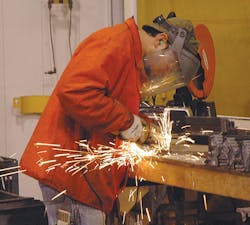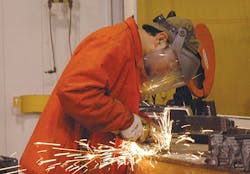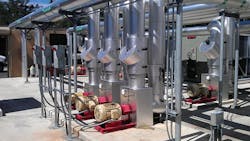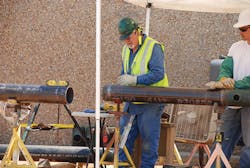2015 Book of Giants — Beware of double-edged swords
U.S. Gross Domestic Product only grew 0.2% in the first quarter of this year. What happened? There are a couple macro-economic trends that may be having an impact.
“Up until six months ago, the U.S. economy was manifesting surging momentum, but the last six months have been disappointing,” says Anirban Basu, chairman and CEO of Sage Policy Group Inc., Baltimore, and chief economist of Associated Builders & Contractors. “The recovery's momentum has slowed to a crawl. Lower energy prices and their impact on investment spending, a stronger U.S. dollar, weather, and the West Coast port slowdown have all conspired to undo the economic momentum apparent during mid-year 2014.”
To download a pdf of the complete Book of Giants, including rankings of the Top 100 mechanical contractors in the country by revenue, click here. Viega LLC is sponsor of the 2015 Book of Giants.
Here’s where the doubled-edged sword comes in. The high dollar and lower energy prices are good for some customers and bad for others. All that work in the Dakotas on fracking, shale gas or tar sands has slowed to a crawl. The oil companies aren’t engaging mechanical contractors for new builds and they’ve laid off a lot of their own workers. On the other hand, if you’re an electric utility or steel mill, cheap gas is terrific. For a steel mill, that cheap feedstock is great. But for a steel mill building tanks and pipe for the oil industry, it’s bad. If you’re manufacturing plastics or asphalt and the like, cheap oil is great.
A couple years ago, a Euro was worth $1.35. Today it’s worth $1.05 and the two currencies may reach parity. That makes imports cheap, but for U.S. manufacturers in the export market, it’s killing them.
The U.S. has been a net exporter of refined petroleum products, notes Anthony J. Guzzi, president and CEO of EMCOR Group Inc. Low oil prices, however, have lead to massive layoffs in the oil industry. Guzzi says he’s heard job loss figures ranging from 30,000 to as high as 120,000.
Trading good jobs for bad
“That was a good growth industry, but now with the laydown of drilling rigs, we’re substituting good jobs for retail jobs,” Guzzi says. “We’re taking high-skill and high-dollar jobs and replacing them with low-skill, low-dollar jobs. And we’re not seeing the benefit of low gasoline prices. Most people are using the savings to pay down debt. We have not had an active consumer. The low GDP number in the first quarter of 0.2% was caused by bad weather and a slower refining business, and retail can’t overcome what’s going on in energy and the export business.”
" We’re taking high-skill and high-dollar jobs and replacing them with low-skill, low-dollar jobs. And we’re not seeing the benefit of low gasoline prices.
—Guzzi says
Tim Moormeier, president of U.S. Engineering, Kansas City, Missouri, said he’s heard speculation about oil prices that run from $20 a barrel up to $80. (Guzzi believes that $70-$75 a barrel is the sweet spot; high enough to maintain oil patch jobs, but low enough to not slow the U.S. economy.)
“As a company we’ve been making some small inroads in the oil and gas industry at a time when they are scrambling to find way to save dollars,” says Moormeier. “So that’s having an affect on our work opportunities in that market.”
Moormeier says low prices have had a greater impact on middle market firms such as Whiting Petroleum Corp. or Noble Energy or Andarko Petroleum.
“Those guys react much faster,” he notes. “They’re much closer to the economy in terms of what’s going on. They don’t have the capital to fund projects, so they cut back on rolling projects out. I can’t say that it has had any direct impact on other customers such as chemical plants, auto plants and others in our industrial base.”
Will industrial slow?
The strong dollar makes Basu think that the industrial recovery, while still strong, will not continue.
“The U.S. dollar continues to be strong at $1.05 against the Euro,” Basu told CONTRACTOR. “It’s also high against Yen, the Yuan and the Canadian dollar, and that creates headwinds for exporters and makes imports more competitive. The result is slower earnings growth for U.S. manufacturers and diminished investment in the nation’s plants and equipment. That’s not all seen in the current data because a lot of these investments were planned before the dollar became much stronger. And the likelihood is that the dollar will get stronger. The Federal Reserve is contemplating higher interest rates and that makes dollar-denominated fixed-income assets more attractive. Europe is just getting into a quantitative easing program, so the dollar will get stronger. That makes it tougher for exports but better for imports, so manufacturers will not put lot of money into their physical plant.”
"The Southeast, Texas, and some parts of the Midwest have a competitive advantage now.—Guzzi says
Guzzi believes that his customers plan long-term and view low energy prices and a strong dollar cyclically.
“The people we work with make long, long term decisions,” Guzzi points out. “So the Southeast, Texas, and some parts of the Midwest have a competitive advantage now. If the dollar is strong, maybe you’re still better off manufacturing here rather than Europe and bringing back manufacturing from China because of low energy costs. That’s driving manufacturing in the U.S. and that will continue to help the dollar.
“America is the world’s largest manufacturer anyway, and we will continue to see that in our business,” Guzzi continues. We are very busy in plant relocations and expansions, especially in the Southeast. I think China is going to move long term to a globally sourced product, that is, if you’re manufacturing in China, it’s to serve the Chinese market. There’s no big advantage to shipping stuff from China to the U.S., especially when you can consider manufacturing in Mexico if you’re just interested in low-cost manufacturing.”
Basu notes that other sectors of the construction economy are recovering nicely. The number one sector adding jobs, he points out, is business services that require more office space. That’s a big sector in non-residential construction. The consumer remains active even though the numbers for retail sales for the last three months have been disappointing, but online sales are strong, fueling the need for fulfillment centers.
Americans feel more confident, Basu maintains, with unemployment down to 5.5% and wage pressure building. Wage growth is at its highest level in six years. Basu says he’s seen announcements by more companies for wage increases, which will contribute to higher retail spending and higher retail-related construction.
Contractors note that online retailers, such as Amazon, are building distribution centers, so that they can deliver to customers faster. Data center work, a mainstay for mechanical contractors the past few years is changing. Previously, a lot of the work was for local firms such as banks. Now national firms, such as Apple or Yahoo, are building data centers.
Basu expects increased hotel construction as more Americans can spend money on vacations. Occupancy rates and nightly rates are both up, generating money for both new construction and renovation of existing hotel rooms.
Multi-family is strong
John E. “Tripp” Ahern III, president and CEO of J.F. Ahern Co., Fond du Lac, Wisconsin, says that his firm, which specializes in both fire protection and HVAC, has gotten more work in urban centers, such as Minneapolis, Milwaukee or Chicago.
"We can see in our particular case where a project might be appealing from the fire protection standpoint and less so for HVAC, or vice versa.”—Ahern says
“We have done a fair amount of high-rise residential work over the year,” Ahern says. “A lot is going on in a number of places, but not all of it is equal. Some of it is very high end, very expensive, high quality construction, and other projects are pure apartments, less expensive type of housing. There’s a definite difference in the type of competitors who pursue various forms of that work. We’re performing plumbing, HVAC, fire protection and automated controls, and we can see in our particular case where a project might be appealing from the fire protection standpoint and less so for HVAC, or vice versa.”
Government spending remains an X-factor. Moormeier reports that U.S. Engineering’s public work is going well, with projects for the New York Federal Reserve, universities and other higher education, and federal contracts for the Department of Energy, Homeland Security, and the Air Force.
Infrastructure spending may suffer, however, because of the gridlock in Washington. Other than airport construction, which is often funded locally, most infrastructure money comes from the federal government. That spells trouble for water supply and wastewater treatment projects.
“Everything ebbs and flows at various times,” Ahern says. “So that’s why multi-family residential developers today have a clear business case for wanting to expand the number of rental units available in cities. We’ll see how long that lasts. For the overall economy we’ll see modest growth in 2015, and we’re really looking forward to 2016 and ’17. We think those will be good years. The low point for us was 2011 in terms of volume and we’ve seen a nice, steady climb upward from that point. 2014 was an all-time record sales year and we should eclipse that this year. The key issue is going to be making sure we have enough young people entering the construction industry over next several years … that will be our biggest challenge.”
About the Author
Robert P. Mader
Bob Mader is the Editorial Director for Penton's mechanical systems brands, including CONTRACTOR magazine, Contracting Business and HPAC Engineering, all of which are part of Penton’s Energy and Buildings Group. He has been with CONTRACTOR since 1984 and with Penton since 2001. His passions are helping contractors improve their businesses, saving energy and the issue of safeguarding our drinking water. He is a graduate of the University of Notre Dame with an A.B. in American Studies with a Communications Concentration.



